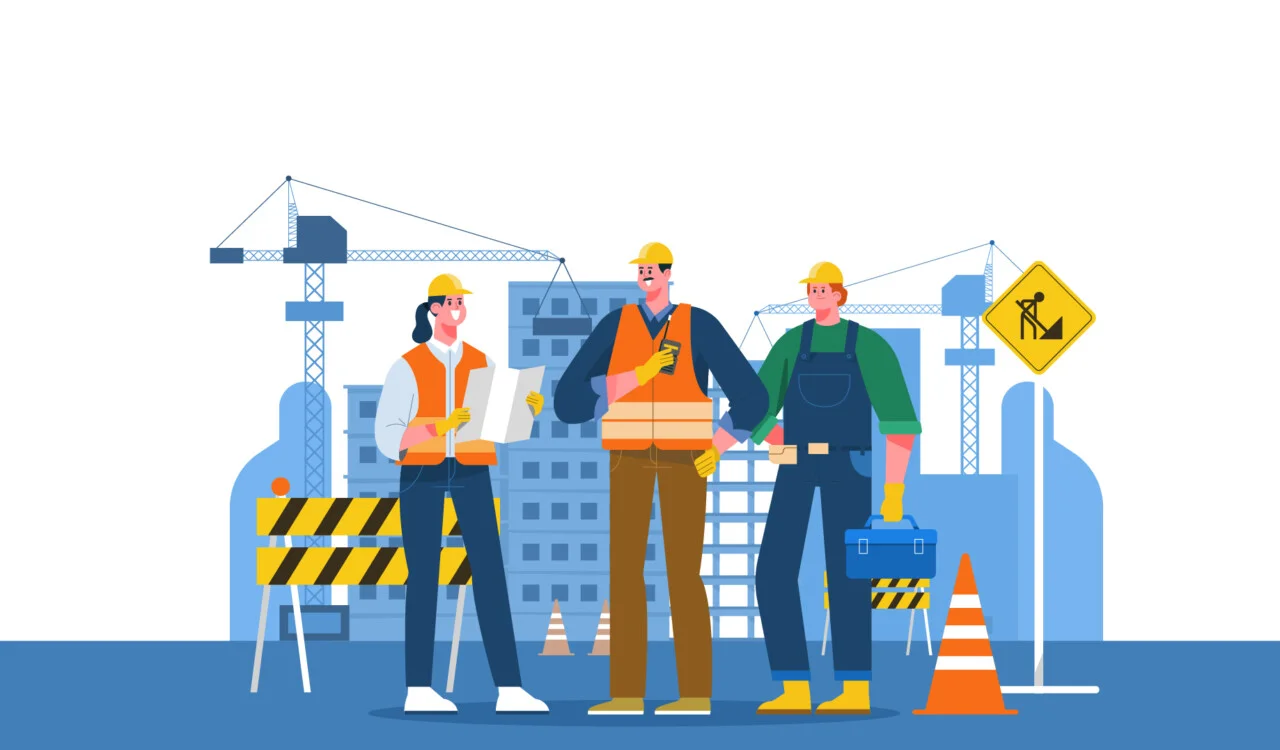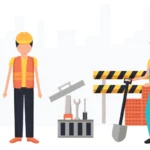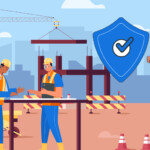From job site hazards to potentially risky workflows, toolbox talks cover essential precautions and site-specific safety concerns. Think of them as necessary safety refreshers, creating a space for open discussions on questions, comments, and safety-related concerns.
The lack of proper safety measures exposes workers to a multitude of risks on a construction site. Given the array of building materials, toxic chemicals, machinery, heavy equipment, and potential hazards such as heights and sharp objects, it’s evident that construction work carries inherent dangers.

In construction safety, toolbox talks play a crucial role in keeping the workforce informed and vigilant. These brief safety meetings, also known as tailgate meetings or safety briefings, serve as a platform to address various construction safety topics relevant to the work site.
The construction sector experiences a higher fatality rate compared to other industries. In 2019, nearly 20% (1,061) of worker fatalities in private industry were attributed to the construction industry, constituting one in every five worker deaths, as reported by OSHA violations report.
In 2017, “falls” accounted for 39.2% of all deaths in construction, with 381 out of 971 deaths attributed to this cause. Additionally, in the same year, 80 out of 971 deaths, or 8.2% of the total, resulted from construction workers being struck by objects.
Construction crew management is incomplete without toolbox talks. Read ahead to understand why it is important and the 7 crucial topics you must cover during it.
Understanding Construction Safety Toolbox Talks
Robust prevention is the only defense against the common hazards. Conducting toolbox talks, covering various construction safety topics, and adopting technology safety solutions serve as a proactive method.
Furthermore, these meetings serve as an opportunity to explain new safety policies and procedures. It’s also an ideal time to provide training on recently introduced safety rules and regulations, ensuring ongoing OSHA compliance.
Key Tips for Successful Construction Safety Toolbox Talks:
Toolbox talks are usually led by a construction manager, safety supervisor, or an individual familiar with the project and safety protocols.
The meeting addresses various subjects, adapting to team needs and project stages. Common construction safety meeting topics include fall protection, hazard identification, electrical safety, personal protective equipment, hazard communication, use of safety app features and emergency procedures.
Here are a few tips to conduct a successful toolbox talk-
Clearly Define Objectives: Before the meeting, establish clear objectives and goals to maintain focus and ensure the thorough coverage of all essential construction safety topics.
Utilize Visual Aids: Enhance understanding by incorporating visual aids such as diagrams, images, or safety app demo videos. These aids not only simplify safety concepts but also make meetings more engaging.
Introduce Interactivity: Make meetings more engaging by including hands-on activities or lone worker safety app download demonstrations. This interactive approach reinforces safety concepts and sustains worker engagement throughout the session.
Conduct Follow-ups: After the meeting, follow up with workers to confirm their understanding of the presented safety information and to ensure the implementation of appropriate safety procedures. This post-meeting interaction reinforces the significance of safety and encourages a serious commitment to it.
7 Key Meeting Topics for Your Toolbox Talks
For your next toolbox talk, consider focusing on 7 key construction safety topics-
Fire Safety
Construction site fires should be a recurring topic in construction safety meetings due to their severe consequences such as fatalities, injuries, and significant property loss. The seven most frequently identified causes of construction site fires are:
• Electrical failure/malfunction
• Abandoned, discarded materials/products
• Heat sources too close to combustibles
• Cutting/welding too close to combustibles
• Unclassified misuse of materials/products
• Unattended equipment
• Failure to clean
To reduce fire risks, address common hazards in toolbox talks, stressing the importance of worksite vigilance. Guide fire extinguisher use and emphasize accessibility by preventing obstructions. Also, focus on raising SOS alarms within the worker safety app to instill confidence in your workers to face such a hazardous situation.
In distress, employees can activate an SOS signal by pressing the app’s designated button or tapping the phone’s ‘power’ button. This, along with location sharing, ensures a swift response, contributing to overall worker safety on construction sites.

Electrocution
Prioritizing electrical safety is crucial, especially near heavy machinery or high-voltage areas. In safety meetings, reinforce protocols for handling electrical issues, typically managed by qualified electricians. Electrical injuries, part of OSHA’s fatal four, may not be as frequent as falls but can be fatal. Regularly revisit this topic to refresh everyone’s memory, ensuring ongoing awareness and proper training for new workers on electrical safety practices.
Fall Protection
Discuss the optimal safety footwear for preventing slips and falls, and highlight proper storage for tools and equipment.
Fall Hazards
Falls, one of the OSHA fatal four, pose significant risks on construction sites. Involve your crews in identifying fall hazards and assessing job-specific risks. Discuss preventive measures like safety harnesses, anchor systems, netting, guardrails, or barriers, seeking crew input on effective methods. Collaboratively, also assess the condition of existing fall protection equipment for needed repairs or replacements.
Falling Objects
Falling objects from heights contribute to construction-related injuries and deaths. Discuss preventive measures like, safety barriers, or tool tethers/lanyards, and enforce safety compliance for proper item placement and to avoid leaving small objects unattended.
Hazard identification and communication
In safety meetings, ensure your crews are aware of the unique hazards on their job site. Encourage discussions on vigilance and reporting procedures for new hazards.
Enhance hazard communication using a safety app with in-app communication and alerts. Utilize features like Multi-Channel Alerts, enabling communication through text, email, or IVR calls for improved real-time response. This supports integration with back-office or operations call center systems for comprehensive safety management.
First Aid
Utilize construction safety talks to reinforce fundamental first-aid knowledge among your workers. In certain instances, OSHA may mandate specialized training, particularly in fields such as logging operations, electric power, shipyard employment, or other specific sites. Cover specific first aid applications during these talks, including dressing wounds, addressing burns, and eye flushing. Prompt your crews to discuss job-specific first aid requirements. Additionally, appoint a designated individual responsible for ensuring OSHA-mandated first aid kits are both up-to-date and fully stocked.
Addressing the Unique Challenge of Lone Workers in Toolbox Talks
Lone construction workers face various common issues, including:
- Falls from height
- Struck by object incidents
- Being caught in or between equipment or structures
- Slips, trips, and falls
- Electrocution risks
- Working in confined spaces
- Exposure to harmful substances or environments
Risk Awareness and Toolbox Talks:
Construction managers can kick off toolbox talks by spotlighting the unique risks faced by lone workers. Discuss scenarios where delayed responses and limited assistance can pose challenges. This sets the stage for a comprehensive understanding among all team members.
Comprehensive Education:
Toolbox talks offer an ideal platform to educate the workforce about lone worker safety app adoption. Covering topics such as risk mitigation, emergency response protocols, and the importance of vigilance ensures that everyone is well-informed and contributes to a safety-centric culture.
In the often hazardous environment of construction sites, worker well being is of paramount importance. Construction work frequently involves working alone, operating heavy machinery or undertaking tasks in isolated areas.
Construction workers need a solution that guarantees immediate safety monitoring, automatic check-ins, and accurate GPS locations in case of emergencies. Recognizing the need for enhanced safety measures and the integration of lone worker safety apps has emerged as a crucial solution.
Features of a Lone Worker Safety App to Highlight In Your Toolbox Talks
On construction sites, ensuring the safety of lone workers is paramount. These individuals often operate in isolated or remote areas, facing unique risks without immediate assistance. The lone worker safety apps address this concern by providing real-time monitoring, immediate communication channels, and streamlined emergency response protocols.
These apps not only mitigate potential risks but also demonstrate a company’s commitment to prioritizing the well-being of its workforce. Embracing this technology aligns with industry standards and legal requirements, fostering a culture of safety and care within the construction workplace. The must-have features in the apps are:
Application Notifications and Alarms
An integral feature for enhancing worker safety within the app involves a proactive notification system. This system regularly prompts lone workers to check in, ensuring their ongoing safety while on the job.
Timely check-ins are facilitated through in-app alarms that notify lone workers when it’s time to confirm their well-being. Additionally, users have the flexibility to opt for reminders via SMS, email, or phone calls, ensuring they stay connected and reminded of their check-in obligations.
Cloud-Based Dashboard
Within the safety app, the inclusion of a cloud-based dashboard offers employers an encompassing command center for overseeing mobile lone workers. This centralized platform conveniently consolidates all active statuses and locations, offering a comprehensive view, especially for employees in potentially hazardous situations.
The online dashboard’s compatibility across multiple devices empowers employers to monitor employee safety effortlessly, regardless of their location. It fosters real-time oversight and response capabilities.
Worker Location Tracking
Incorporated within lone worker safety solutions, real-time location monitoring offers real-time updates on a field worker’s location, crucial in emergency scenarios. Managers gain access to live employee status updates, encompassing vital details such as ‘location,’ ‘last activity,’ ‘battery level,’ and additional relevant data.
Customize automated workflows to suit the distinct operational demands of your worksite. This tailored approach ensures personalized safety monitoring and enhances threat detection capabilities, aligning closely with the specific needs of your work environment.
Rules & Alerts
Within the app, employees should have the ability to trigger a safety alarm manually during emergencies. With allGeo, employers can conduct routine safety checks through intelligent safety workflows and establish personalized multi-level threat escalation protocols, including direct connections to local emergency services like 911.
Conclusion
The construction industry’s label as the most dangerous occupation in 2021 underscores the ongoing challenge of creating accident-free workplaces. Site managers and supervisors have a crucial duty to minimize risks, especially for lone workers like plumbers and electricians conducting house visits.
Toolbox talks play a pivotal role in addressing safety concerns, fostering communication, and instilling a culture of vigilance. Recognizing the unique challenges faced by lone workers, a lone worker safety app emerges as a vital solution, providing real-time updates and triggering alerts during emergencies.
Prioritizing the safety of lone workers is integral, with employers equipping them with necessary tools and integrating safety considerations into risk assessments. The rapid response enabled by a lone worker safety app becomes crucial for mitigating the impact of accidents like electric shocks or falls. Combining toolbox talks with advanced safety technology offers a comprehensive approach to making construction sites a lot safer and ensuring the well-being of every worker.


